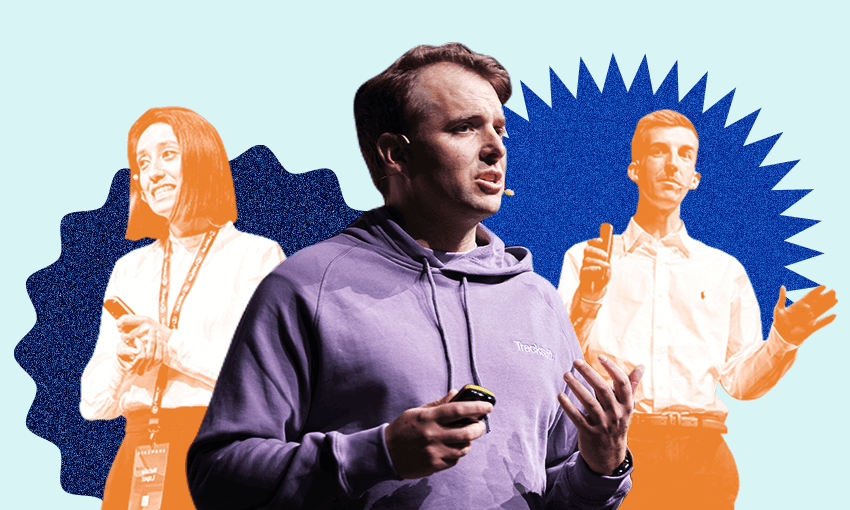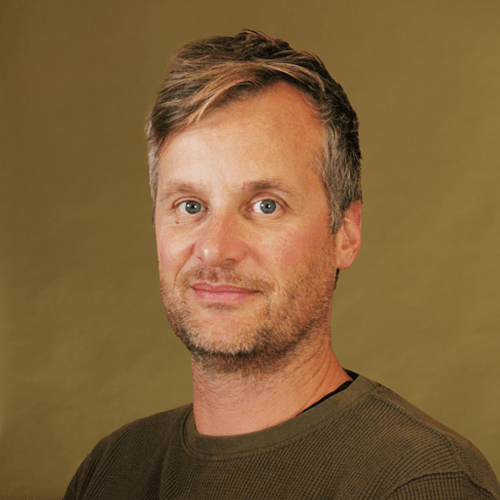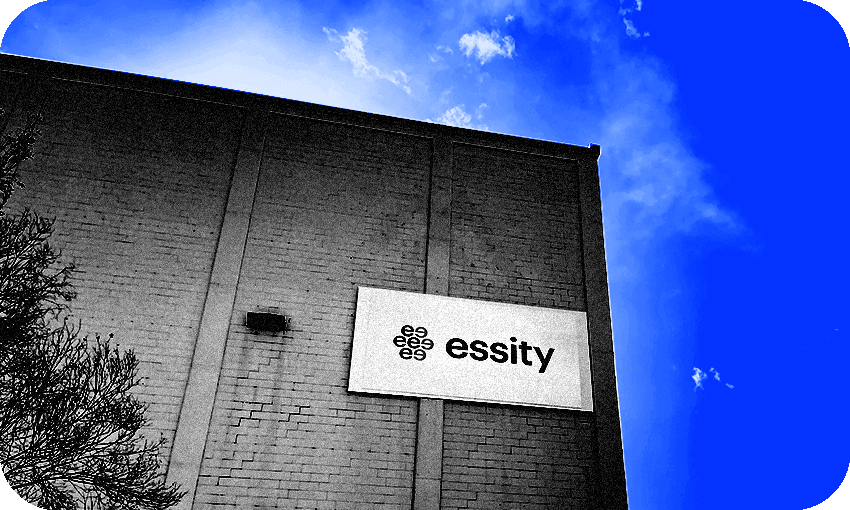At a glitzy invite-only event, 10 CEOs get five minutes to pitch their startups to some of the country’s richest investors. Chris Schulz was there too.
Connor Archbold wants to stand out. Up against nine other CEOs picked to appear on the same stage he’s just walked onto, he needs to stand out. Most wear suits, but, as a gimmick, he’s dressed differently, pairing a purple hoodie with matching sweatpants. His ruse seems to be working. “It turns out when you start a company called Tracksuit, you have to wear a tracksuit to your first ever big pitch,” Archbold quips. Heads look up from phones and giggles ripple around the 1000-strong Spark Arena crowd.
As Archbold continues, I watch an older man much wealthier than me pinch a bread roll off his neighbour’s plate, rip it in half and smear it in whipped goat’s cheese. The others at our table, including three people called ‘Chris’, share a bottle of Merlot. They and everyone else watching Archbold’s presentation, including 1000 on the official livestream, are the “10% of the 1%,” according to Icehouse Ventures CEO Robbie Paul. In other words, incredibly wealthy investors looking for the next hot thing to plunge some play money into.
Probably none of them threw on a dress shirt and shoes in their beaten-up Toyota 10 minutes beforehand like I did. Instead, guests have donned their finest business attire, with expensive shoes and watches gleaming almost as brightly as the dazzling lights coming off the stage. Luxury Lexus cars are dotted around the dining area, and dubstep blasts from speakers, interrupted by Lorde’s ‘Green Light’ and Daft Punk’s ‘One More Time’. The smell of exotic fruit perfumes is overpowering.
It’s the first live Icehouse Ventures Showcase in three years, and everyone’s gone all out for the occasion. The vibe is the TV show Dragons’ Den crossed with a black tie gala event. Those chosen to talk have been handpicked from a pool of 100 startups, and they each get five minutes to sell themselves. “There’s always a tonne that would kill for a slot,” Paul tells me. Some already have willing investors queueing up. Icehouse, which boasts of helping Sharesies, Halter and Crimson get to where they are today, wants to present those kinds of companies to their investors. “I’m not sure if the audience appreciates some of the battles we go through to get these people on stage,” says Paul.
Tonight, CEOs from companies across the business spectrum spend their five minutes touting platform developments, tech innovations and health breakthroughs. They pull out all the stops to win investors over, tugging at heartstrings, referencing environmental problems, using Ted Talk tactics and promising big gains. “Strap yourself in,” says Parrot Analytics CEO Wared Seger, whose company helps Hollywood decipher streaming trends. Graphics and graphs flash up on big screens. Acronyms like “YOY”, “ACV” and “SAAS” are used constantly. The results are as confusing as they are mesmerising.
Archbold, though, is nailing his presentation. He’s doing so by being crisp and clear, and cutting straight to the chase. His company Tracksuit offers real-time brand awareness, and it’s already doing well here and in Australia. The figures he reels off, which The Spinoff has agreed not to repeat, are impressive. “Marketers everywhere are totally freaking out about the cookiepocalypse,” he says, referencing Apple’s recent privacy changes preventing cross-app tracking. “We are bootstrapped, cashflow positive, funded only by our revenue to date.” It’s been operational for 16 months.
Five minutes goes fast, and a dinner of roast lamb and gnocchi is about to be served. But not before the occasion slightly gets the better of Archbold. With the end in sight, he stumbles ever so slightly, tripping over a phrase he’d already delivered confidently during rehearsals earlier that night. But his purple tracksuit, which makes him look like a much skinnier member of the Teletubbies, lowers expectations. He and the crowd laugh off his confusing tongue twister. Loud music and smoke machines play Archbold off stage to the night’s biggest round of applause. Down the back, a crew of 10 tracksuit-wearing Tracksuit staff cheer the loudest.
A few hours earlier, Archbold and his peers weren’t feeling quite so confident. In a backstage green room usually reserved for touring musicians to prepare for performances in front of 12,000 screaming fans, three young CEOs nervously down glasses of champagne and cans of lager as they prepared for their five minutes of fame. “The nerves start building up closer to it,” admits Will Hewitt, the CEO of HeartLab, whose wild hair gives him the permanent appearance of someone who has just emerged from a wind tunnel.
Hewitt’s there to ask for investment in a tool he designed at university to help doctors diagnose heart problems faster. He’s scheduled to appear on stage second-to-last. Ben Scales, the self-contained co-founder of KiwiFibre, agrees with him, but he’s been told he’s only got four minutes. “I think they tell people that so they don’t go over five,” he says. Scales is the calmest one in the room, and there’s a reason for that. He started his company KiwiFibre with William Murrell, and together they turn flax into a natural, sustainable, environmentally-friendly fibreglass substitute. It can be used for almost anything: “Yachting, geo-spacial engineering, motorsport, aerospace, automotive, sport and rec,” says Scales.
Casually, Scales mentions recent negotiations with a potential $25 billion customer, “the 606th biggest company in America”. With a source of money like that nearly on the hook, why does Scales need to fish for smaller investors at tonight’s showcase? “Because we need to get many ducks in a row in the exact right co-ordinates to kick the ball off,” he says. “It’s about visibility.” Hewitt, whose company is also operational, has a different reason to court investors: he wants to go global. “We’re at a really exciting point in the company,” he says. “We’ve got clinics using our software. It’s about supercharging our launch into the States.”
Everyone has the same attitude to their five-minute presentations. “Telling a story,” says Scales, “is the only way to get people engaged.” Yes, he’ll be dropping in news of his potential $25 billion customer, but he’ll be saving it for the end. “I’ll start by addressing environmental problems first,” he says. Scales already had a walk around the venue to size up who’s in the crowd. He’s spotted “some Olympians, some knighthoods”.
As we talk, Archbold appears to be regretting his decision to wear a tracksuit, and rips off his hoodie. “It’s so hot – my pit stains are going to be through the roof,” he says. I wish them good luck and prepare to leave, but Hewitt stops me and hands me an investment interest form. Always hustling, it’s an attempt to convert me into a HeartLab investor. “Now you’ve got this form,” he says, “you can [invest] too if you want to.” I nod and think about my ageing Toyota, with its curious interior scent of wet dog combined with petrol, and head to my table.
After dinner, there’s a pause in proceedings, so I begin mingling, asking around to try and find out what investors think of the companies that have appeared on stage. Will they invest? Despite seeing them scrolling frantically through CEOs’ LinkedIn pages, those sitting at my table seem to be there just for the show. One says he doesn’t directly invest in companies, only managed funds. “There’s less risk,” he says. He’s there because he once worked for a company that received funding through Icehouse. Another plunges a forkful of slow-cooked lamb into his mouth and says he won’t be investing either, but he’s enjoying the networking opportunities.
I wander around and attempt to start up conversation. Two confuse me as a potential investor, which makes me laugh heartily. When I correct them and reveal I’m a journalist there to cover the night, conversation seems to quickly dry up. “The food was good,” I say to one, trying to win them over. “The food was fine,” he slurs back. When dessert, a glass laden with far too much vegan dark chocolate mousse, is delivered to tables, it’s an indication the next batch of CEOs is about to arrive on stage.
Scales walks on stage confidently and nails his pitch. He’s right: touching on environmental concerns lands well. Hewitt’s hair has calmed down and he delivers a measured, heartfelt plea. Seger, from Parrot Analytics, oozes confidence. Natalia Lopez, from Kitea Health, makes complicated health issues seem simple. Her company makes implants that measure pressure in the brain, a gamechanger for children, she says. Unlike Dragons’ Den, questions aren’t allowed. Instead, investors mark their interest in a company on a piece of paper and hand it in at the end of the night. Emails will be exchanged and Zoom calls set up over the coming weeks.
It’s all done by 9pm, so I corner Paul, Icehouse’s CEO, in the same green room that everyone was prepping in earlier. He breathes a sigh of relief, pours himself a glass of wine, places the bottle and the glass on the table so they frame him, then doesn’t touch them again. Holding an event like this over Zoom, as they did for the past two years, doesn’t do it justice. “Venture investing is tangible, it’s personal, it’s visible,” he says. “For us to get people together and hear from companies … it makes all the difference.”
Investing in startups, Paul admits, is risky. He readily admits that only one or two out of 10 really fly. So why do it? “The people who tend to invest in startups are aligned to the mission,” he says. It’s not just about making money. “They’re inspired by backing companies, are willing to admit there’s a long time horizon and want to put some of their energy and resources and goodwill into it at the same time as investing.”
He points to success stories like Halter, a solar-driven monitor for cows that allows farmers to work remotely, as a reason to believe. “Companies were second-guessed and founders were laughed at when they first pitched. They’re now generating hundreds of millions [of dollars].” Paul’s job, he says, is match-making. “We have the best job in the world,” he says. “All we do is interact with highly aspirational, very intelligent and driven entrepreneurs who are solving real problems, and investors who are inspired by that. It’s an optimistic community.”
A few days later, I email the CEOs of the companies I spoke to. How did the night go, I ask them. Did any investors get in touch? They all reply quickly. “[We] had an overwhelming amount of interest, and I have spent the past week following up with all of it,” says Hewitt, from HeartLab. “We’ve had a truly overwhelming response,” says Archbold, from Tracksuit. “Night of the year for us I reckon,” says KiwiFibre’s Scales. “Now we have around 300 emails from investors that we’re chipping away at.” The hustle, at every level, continues.
Follow Business is Boring with Simon Pound on Apple Podcasts, Spotify or your favourite podcast provider.




